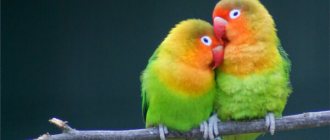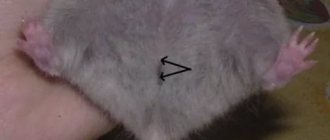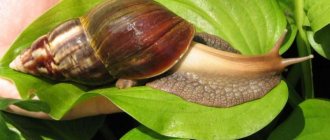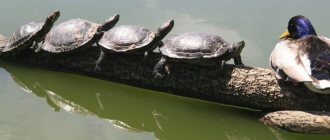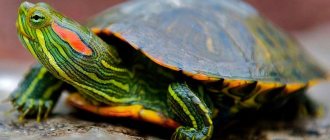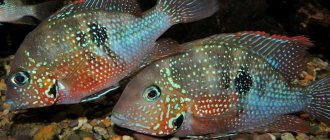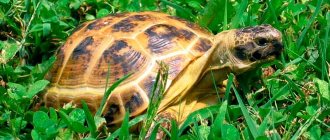Captivity
Red-eared turtles in the pool.
Premises and equipment
An adult red-eared turtle needs an aquarium of 150-200 liters. Dry land should occupy at least a quarter of the area of the aquarium. It is advisable to build a sloping bank from the bottom with a rough but non-scratching surface. On land, you cannot pour soil (gravel) or soil, as the turtle will eat it. The water level should be at least the width of the turtle's shell, which will allow it to roll over if it ends up on its back for any reason. Will eat everything that floats in the water.
The water should be clean and warm (22-28 °C), and should not fall below 20 °C (this often requires installing a heater). It is necessary to settle the water. The water should be changed as it gets dirty, at least once or twice a week. It is possible to install an electric pump with a filter, which does not exclude regular water changes. In addition, it is necessary to install an incandescent lamp and a source of dosed ultraviolet radiation. It is recommended that breeding turtles be given the opportunity to bask in the sun in the summer.
Nutrition
In captivity, red-eared turtles should be fed low-fat, preferably river fish (up to 3%) with bones and offal, once a week or two, depending on the frequency of feeding, beef liver. Everything is given raw. The diet must include snails (all of them: aquarium snails, Achatina and wood snails, from nature only land snails are allowed - all except amber snails), crickets, food cockroaches, earthworms, aquarium fish (guppies, zebrafish, neons, etc.). The diet should also contain plant foods (in adult turtles it should make up half of the diet) - aquarium plants (duckweed, hornwort, pistia, etc.), lettuce, dandelion leaves, plantain, etc. In the aquarium, directly in water, calcium should be present with the turtle. A mineral stone for sharpening bird beaks (Vitakraft Sepia) is suitable for these purposes. This stone is a natural source of calcium for animals (the stone itself is the shell of a cuttlefish, all the accumulation of calcium during its life). This stone is sold in pet stores and bird departments. Of the feeds, the most suitable is Tetra ReptoMin, both as a feed once a week and for a complete diet. You can also use similar foods from Sera and JBL. The only vegetables you can eat are carrots once a month. Turtles up to a year need to be fed every day, after a year once every 2-3 days, strictly once a day.
The red-eared turtle does not chew its food until its head is completely submerged in the water.
Determination of gender
Reliable determination of sex becomes possible in mature turtles that are more than a year old, and it is better to determine sex in comparison with other turtles. In addition to the sexual differences common to all turtles, male red-eared turtles have longer claws and tails than females.
At the age of 2-3 years (in captivity after a year), male red-eared turtles exhibit a courtship instinct. Courtship involves the male “fluttering” his claws in front of the female’s eyes. 1 year: 6 cm. 2 years: female - 9 cm, male - 8 cm. 3 years: female - 14 cm, male 10 cm. 4 years: female - 16 cm, male - 12 cm. 5 years: female - 18 cm, male - 14 cm. 6 years: female - 20 cm, male - 17 cm.
What do land turtles eat?
Land turtles
Naturally, you will have to feed your new pet something. And his health will depend on the correctness of his diet. Therefore, remember the basic rules regarding feeding land turtles. They can be given fruits, berries, vegetables, grass, tree leaves, meat, low-fat cottage cheese, boiled eggs, rolled oats soaked in water. Such turtles are not averse to eating beetles and snails (garden and shellless). The mode and frequency of feeding, as well as the size of portions, depends on the age of the turtle. Thus, young individuals eat daily, while turtles older than a year can eat every other day, but in large portions, and mainly plant foods.
Keeping red-eared turtles
Only at a superficial glance does the turtle create the deceptive impression of an extremely unassuming animal. In everyday life you will face a lot of problems that must be met head-on.
Equipment for the red-eared turtle's home
At home, turtles are kept in specially equipped aquaterrariums.
It is advisable to purchase an aquaterrarium with a volume of 100 to 150 liters, which is filled with water to about 20-30 cm. This is done so that the turtle, if it turns over on its back, has the opportunity to take a normal position without outside help. It is also recommended to build a kind of beach, equipped with a heating lamp and a UV lamp that will disinfect.
The beach should have a slope from the bottom of the aquaterrarium, with a rough land surface, but not causing scratches. It is recommended to place the embankment no higher than 20-30 cm from the top of the aquarium, since some mobile pets are able to get out of their home. The temperature on land should be around 29-30°C.
The water part can be decorated with algae, but before planting them, you should find out if they are poisonous, since turtles love to taste everything. Fish, by the way, do not eat poisonous algae. In addition, the algae must match the lighting level and temperature in the aquaterrarium.
In addition to decorative algae, you can also plant vegetation intended for food. Spirogyra, hornwort, anacharis, duckweed, and ludwigia are suitable for these purposes.
The water should, of course, be clean and warm, about 26-28°C. It should be changed when it gets dirty or once a month.
Feeding
The nutrition of turtles is quite an interesting thing. Firstly, young turtles are fed daily, and adult turtles about 2-3 times a week. Secondly, with age, the content of plant food should prevail. Therefore, if an adult turtle lives in an aquarium, then the algae has been eaten.
Proper nutrition is an important component in maintaining the health of pets. For this reason, you should carefully approach the preparation of your diet. It must include plant food, vitamin and mineral supplements and, of course, fish (cod, hake, thalassa) and meat.
Plant food may contain: abutilone, basil, aloe, oregano, peas, balsam, figs, rudbeckia, clover, coleus, calendula, nettle, onion, alfalfa, nasturtium, arrowroot, daisies, dandelion, petunia, purslane, tradescantia, rose petals, chlorophytum, fuchsia, barley, rose hips, cyperus, kalanchoe, fern, calathea, hibiscus, gloxinia, lawn grass, coffee, plantain.
In the summer, “free” food is available in the form of vegetation: carrot and beet tops, potato tops cannot be given, branches of fruit bushes and trees.
It is forbidden to feed turtles plants such as monstera, epipremnum, philodendron, anthurium, silent, akalifa, croton, jatropha, azalea, delphinium, crocus, morning glory, lily of the valley, lupine, periwinkle, oleander, juniper, nightshade, ficus, philodendrn, shefflera. The listed plants are so poisonous that even from ordinary touch the turtle develops long-lasting wounds and ulcers. If the juice of these plants gets into the eyes of an animal, it causes conjunctevitis.
In some cases, the use of prohibited plants contributes to disruption of the nervous system and gastrointestinal tract.
Therefore, when choosing components for food, you should be careful, since nutrition is the key to your pet’s health.
Lifestyle and habitat
Due to a natural tendency to travel, due to the thoughtless commercial activities of people, the red-eared turtle can be found far from its original homeland.
She captures new living spaces. Which is completely uncharacteristic for reptiles. Attempting to populate previously uninhabited territories has its pros and cons. Expatriates can diversify the fauna of their newly acquired homeland, or they can disrupt the biological balance. This is usually followed by a large or small environmental disaster.
In the last century, red-eared turtles moved to Eurasia. They were first discovered in Israel. Then the reptiles penetrated to the south of Europe. From Spain and France they came to England and central Europe.
The next step was the development of Eastern Europe. Now they can be found in Russia. Not only in the southern regions, but also near Moscow. At the same time, we are talking about survival in Russian frosts, and not about the life of red-eared turtles at home .
With the help of humans, reptiles crossed the oceans. Eventually they made it to Australia. The continent's unique ecosystem has suffered seriously. The animals were declared pests.
The reasons for invasiveness are:
- The high mobility of these reptiles. They remain turtles, but they move willingly and quickly. During the day they can cover many kilometers of distances.
- Omnivorous. The basis of the menu is aquatic plants, but any living creature is also eaten as food, as long as it can be caught and kept.
- The ability to survive without air for months. This quality, unique for vertebrates, allows them to endure winters by burying themselves in the mud at the bottom of a reservoir.
- Turtles are synatropic animals. They can exist and reproduce in man-made environments. In park reservoirs, artificial ponds and canals.
- Another reason was that people liked keeping these reptiles at home. Their breeding began to generate income.
In places where they permanently reside, the animals lead a lifestyle typical of freshwater turtles. At temperatures above 18 °C they actively feed. They like to warm themselves by going ashore, climbing on a coastal stone or fallen tree. At the same time, they constantly monitor the situation. In case of danger, they quickly move into the water. This slippage gave rise to the English nickname slider.
An interesting period in the life of turtles is wintering. When the temperature drops, they fall into a state similar to suspended animation. But this is not hibernation (hibernation) in its pure form, but a variant of it. It involves reducing activity to a minimum and is called brumation.
In mid-latitudes in October, when the temperature drops below 10 °C, the animal becomes numb. In this state, they remain at the bottom in thick silt, in niches under the shore, in hollow tree trunks. In a state of brumation, a turtle may not breathe for several weeks. Anaerobic processes occur in the body, the metabolic rate decreases sharply, the heart rate drops, and vital activity stops almost to zero.
With a temporary increase in temperature, turtles can wake up from torpor and surface to breathe and feed. That is, a short-term exit from suspended animation is realized. In spring, when the ambient temperature rises and the water warms up to 12 °C and above, a return to active life occurs.
We recommend reading: How to grow irises from seeds?
This is how turtles winter in areas with cold winters. If there is no seasonal cold snap, or the maintenance of red-eared turtles takes place under normal conditions, hibernation does not occur.
Continuation of the family line
Even an experienced herpetologist will not tell who is in front of him (a boy or a girl) until the turtle is one year old. It is at this age that sexual dimorphism appears.
Difference between the sexes
It is known that females are much larger than males, but this trait can be considered significant only for individuals born at the same time. Otherwise, it is hardly possible to determine the gender by dimensions.
There are more notable features that help you figure out the gender of your pet. So, in males:
- the spot near the eye is brighter and larger;
- longer claws on the forelimbs that help cling to a partner during copulation;
- the lower part of the body is concave, whereas in females it is flat;
- thicker and longer tail.
Information about the sexual maturity of red-eared turtles varies somewhat. Usually the reptile enters the puberty phase by 5-6 years, and in captivity much earlier.
Pairing
Turtles living in zoos and apartments mate, regardless of the time of year, but, being in their natural habitat, adhere to certain dates (March - July).
The male performs a mating dance, the main role in which is assigned to the claws stroking the chin of the chosen one. Young reptiles can also imitate mating games: but these “rehearsals” do not lead to procreation until the turtle has entered reproductive age.
The partner swims tail first, being very close to the partner’s head, tirelessly tickling her face with his claws. If the female is not against mating, she accepts these advances. If the turtle is not ready for intercourse, it drives away the suitor, using physical force against those who are particularly dull.
Offspring
If sexual intercourse leads to fertilization, the female begins to bask in the sun's rays and changes her eating habits. This is especially noticeable in domestic red-eared turtles and does not develop into a disaster: you just need to adjust the menu, including the amount of food.
About 2 months are allotted for pregnancy, but the period increases if it is impossible to find a good place for laying. Two weeks before “giving birth,” the female almost never leaves the ground, sniffing and digging. Having decided on a laying site, the reptile moistens it with liquid from the anal bladders and digs the ground with its hind limbs.
The red-eared turtle is a bad mother: having laid eggs (from 1 to 22), she completely forgets about the offspring. Incubation, the duration of which depends on temperature, takes from 100 to 150 days. The temperature in the nest also affects the sex of turtle babies: at 29°C and above, girls are born, at 27°C and below, only boys are born.
To emerge from the egg, newborn turtles pierce the shell with an egg tooth, which falls off after an hour. All babies have a small pouch on their abdomen with the remains of incubation provisions: when it falls off, it leaves a quickly healing wound.
How to treat an animal?
If this is your first time getting such a pet, don’t get lost. There is nothing difficult about caring for red-eared turtles at home. You just need to know what they are capable of and how they perceive our world. These four-legged animals have well-developed vision and sense of smell (turtles distinguish colors, detect other people's motor activity at a distance of up to 40 meters, and look for food by smell). But they hear poorly: after all, their ears are covered with skin. Only vibration and dull sounds are available to them. The shell is not just armor and protection, it is a part of the body that is very sensitive to touch because many nerves pass through it. Taste buds are also well developed: pets can refuse tasteless food in favor of some favorite treat.
The animals themselves make a variety of sounds: squeaks, snorts and hisses. Do not forget that turtles cannot breathe underwater; to breathe, they must rise to the surface. In general, these are very sensitive creatures that require special care. Organizing it is not at all difficult, the main thing is to follow the recommendations correctly.
As soon as you have a pet, get ready for a pleasant acquaintance, try to get to know your red-eared friend (or friend) better. Read the article: How to determine the sex of a turtle! Show it to the veterinarian: you won’t be able to make sure on your own that the new family member hasn’t brought a bunch of turtle diseases. If you already have turtles living in your house, don’t rush to add a new one to them. Arrange a kind of quarantine for her for 2-3 months (during this period you can make sure that the red-eared one is healthy).
Your pet needs time to adapt to an unfamiliar environment
During this difficult period, try not to bother him with your attention, do not pick him up
How to distinguish a newt from a lizard?
Undoubtedly, newts and lizards have similarities: a flat or slightly rounded tail, a similar structure of the legs and body, a “snake-like” head, a multifaceted color palette of skin coloring, movable eyelids covering the eyes. It is quite easy to confuse a newt and a lizard. And yet, a newt can be distinguished from a lizard by certain characteristics:
- Among the external differences, it is worth noting the completely different type of skin: in lizards it is scaly, but in newts the skin is completely smooth, mucous to the touch.
- As for the tail, newts do not have the ability to cast it off and regenerate it, while the lizard easily and “carefree” gets rid of this part of the body in case of danger.
There are differences in the structure of the organs:
- A feature of lizards is a hard, ossified skull, but in the newt it is cartilaginous;
- The lizard breathes with its lungs; in the newt, the respiratory system involves both the lungs, residual gills, and skin;
- Lizards are viviparous or lay eggs - depending on the species, the newt prefers to reproduce in the water element according to the principle of spawning.
Types of islets
- Islands made of glass are very popular. To do this, a square is cut out of glass, the dimensions of which are 3 times the size of the animal and glued to the walls of the aquarium using sealant. Natural pebbles are glued to the surface of the glass, also using sealant. Thus, the surface will not be slippery, and natural pebbles create a natural look. As a ladder, you can use the same glass with identical inlay or a piece of rough plastic. All work should be carried out in a dry aquarium, and you can move the turtle into it after two days, when the sealant has dried and the smell from it has disappeared.
- Using a piece of tile, you can make a similar island, as in the first case. But the tiles are very smooth and it will be uncomfortable for the turtle to move on it. In this case, you can stick a piece of green rubber on the tile, which will resemble grass.
- An island for a turtle can be made from wood, having previously treated it so that it is resistant to water, otherwise it will quickly rot and spoil the water in the aquarium. This island can be painted or coated with waterproof varnish. This results in the same problem: the island will be smooth and she will not be able to climb onto it.
- The simplest and most ideal material is to use large stones to construct an island. Since the stones are of natural origin, it will be absolutely safe for the life of the animal, and they also have a natural roughness, which is ideal for a turtle. The ideal place for an island is a corner of the aquarium. There is one more serious advantage in organizing such an island: you don’t have to pour out the water from the aquarium and move the turtle to another, less cozy place. Before laying the stones, they should be washed well with soap and boiled for 5 minutes.
It is not recommended to use material such as polystyrene foam to build an island. Polystyrene foam would be ideal for such a design: it is able to retain heat for a long time and has an acceptable roughness. Unfortunately, it is also capable of crumbling. In other words, it is not durable, especially if the turtle suddenly decides to test the strength of his island. She may take a small bite and choke. Sometimes floating islands are made from foam plastic, but they are still not suitable for turtles: the turtle will not be able to climb on it, and if it does, it will not be able to stay on it. It is not recommended to make such islands by placing small driftwood or branches in the aquarium. They will very quickly begin to rot and spoil the water.
If there are no options and there is no desire to make such an addition to the aquarium, then you can purchase a finished product at a pet store or order it online. It is quite possible that this is the simplest and most quickly resolved option, which will cost some money, but will save you from worries.
musky
The smallest species of domestic turtle. The length of the carapace reaches an average of 7-10 cm, less often it grows up to 14 cm. The musky has an interesting color: a dark monochromatic body, bright light stripes on the neck and head and along the edge of the shell, which create an expressive contrast.
To maintain it you will need only minimal effort and general knowledge, since it is difficult to find a more unpretentious pet. It can eat absolutely everything: from small crustaceans and fish fry to lettuce, dandelion, and algae.
There is an opinion that musk turtles can only live in shallow water. It's a delusion. Like all semi-aquatic reptiles, they need a sufficient amount of water and an island on which they can rest and warm up.
Chinese Trionix
An unusual, exceptional turtle with a soft, leathery green shell without scutes. Does not grow more than 20 cm.
There is another amazing feature of them - a trunk instead of the usual nose, and three toes on their paws. There are dangerous sharp edges on the Trionix's jaw, thanks to which the animal grabs prey in the water.
In China and Japan, these turtles are eaten with pleasure; their meat is valued and considered a delicacy. Trionics itself feeds on fish and crustaceans.
If you decide to keep one at home, remember that this is an active, responsive turtle that can be aggressive and bite. It is very difficult to tame her. To maintain it, buy a spacious 250-liter aquarium with a thick layer of soil at the bottom and fill it with water.
Bolotnaya
Despite its rather unprepossessing appearance, the marsh turtle is a fairly common inhabitant of home aquariums.
- Firstly, such an individual is easy to buy.
- Secondly, it is not difficult to care for.
- Thirdly, it feeds on both fish and plant food.
It is exclusively freshwater. With good care, it grows up to 35 cm. Does not require large volumes of water: in nature it can stay away from water for a long time, feeding on land.
The marsh turtle needs a spacious (from 100 liters) aquarium with a fairly large island - it can occupy up to 50% of the area. The temperature is the same as for all other types: 27-32°C.
Whatever type of turtle you choose, remember: good care, attention and care will allow you to admire a healthy and beautiful pet for many years!
How to choose the right turtle for your home
When choosing a charming reptile, howbuysell advises paying attention to several nuances at once
When to buy?
The best time to purchase a pet is to choose the period from late spring to early autumn. In the warm season, it is less likely that the animal is sick and will not catch a cold while it is being transported to a new apartment.
Where to buy a turtle for your home
Immediately give up the idea of buying a turtle from strangers or at a flea market: this way you can end up with an individual infected with some disease or an individual protected by the Red Book. It is best to contact breeders, specialized stores or nurseries.
When purchasing, ask to see a veterinary certificate (copy) about the animal’s health status, take the sales receipt.
Health Indicators: How to Choose a Healthy Turtle
- Turn the turtle over onto its shell - if the individual is sick, the legs will simply hang.
- If you bring your finger to the animal’s head, it will quickly retract into the shell.
- The nose and eyes must be absolutely clean, without any discharge.
- Take courage and look into the reptile's mouth - there should not be any plaque or wounds with defects. The palate and tongue should be clean and slightly pink.
- A healthy turtle should not breathe through its mouth.
- The shell must be without a single flaw: there should be no chips along the edges, scratches or stains.
Now you know the general rules on how to choose the right turtle. It remains to decide which type is preferable. The most unpretentious are the land (Central Asian) and red-eared turtles.
Description
Name (Rus): Red-eared Name (Latin): Trachemys scripta
The wrinkled shell of an adult red-eared turtle can reach a length of 60 cm, depending on the subspecies. The spot behind their eyes is not only bright red, but also bright yellow. In general, the colors of these turtles are extremely diverse, and in addition, they change greatly with age. Old animals can even become completely black, while young animals can become bright green. The plastron of turtles is bright yellow with dark round spots. During the first 1.5 years of life, they are able to grow up to 7.5 cm, then growth slows down and the turtle grows 1-1.25 cm per year.
Habitat
From southern Virginia to northern Florida and Kansas, Oklahoma and New Mexico in the west (USA), Mexico, all of Central America, northwestern South America (northern Colombia and Venezuela). The species is introduced to southern Florida, Arizona, Guadeloupe, Israel and South Africa. They live in small lakes and ponds with low, swampy shores.
Nutrition
Young turtles are fed every day, adults 2-3 times a week. You have to work out the amount of food yourself, depending on how much the turtle eats. Typically, for babies the volume of food is 2-3 pieces of 1 cm3, for older adults 2-3 pieces of 2-3 cm3. The food should be raw and at room temperature. Young turtles are PREDATORS, adults are omnivores (that is, in addition to animal food, they also eat plant food). The main food is FISH! It is best to give live small fish that can be immediately introduced into the aquarium. Types of food: FISH (lean and different types - hake, cod, gobies, thalassa, etc.), MEAT (chicken, pork, beef liver), INSECTS (daphnia crustaceans, gammarus, bloodworms, earthworms, legless crickets, wood lice, locusts without legs, beetles), OTHERS (small freshwater snails, shrimp, squid, tadpoles, frogs), PLANTS (lettuce, nettle, dandelion leaves, cabbage, duckweed and other aquatic plants, also slices of carrots, apples, cucumbers). The turtle should receive vitamins and mineral supplements. For these purposes, either calcium-containing fertilizers and vitamins (Wardley and other companies) are added to the feed, or a complete and varied feed is given. It is also advisable to place a mineral block neutralizer for turtles in the aquarium.
Reproduction
Turtles become sexually mature in nature at 6-8 years of age, and in captivity at 4 (males) and 5-6 for females. In March or April, the mating season begins: each male, having met a female, manages to end up right in front of her face, and very close. The female swims forward, and the male swims backward, tickling the female’s chin with his long cats. The eggs of red-eared turtles are no larger than 4 centimeters. To lay them, the female leaves the reservoir and comes to land. Having found a suitable place, she heavily wets the ground with water from the anal bladders. After this, it begins to dig a hole with its hind legs - a nest. The nests of red-eared turtles look like a ball with a diameter of 7 to 25 centimeters, in which females lay 5-22 (6-10) eggs, which they then bury. The incubation temperature is from 21°C to 30°C and the duration is 103-150 days. At an incubation temperature below 27°C, males hatch, and at temperatures above 30°C, only females hatch.
Temperature conditions in the aquaterrarium and its maintenance
To provide your beloved turtle with all the necessary conditions, you need to make a certain amount of effort. The size of the aquaterrarium should be impressive. The aquatic environment should make up 75% of the total area of the turtle's home.
Note! A red-eared turtle can live without water for just a few days; do not experiment on your pet and do not keep the reptile without water for a long time!
The water temperature for the red-eared slider directly depends on the season. It is best to create the following temperature regime for adult turtles:
- In the winter and spring periods of the year from +20 to +25 degrees, subject to consecration for at least 8 hours.
In the summer period of the year from +25 to +28 degrees, subject to consecration for at least 13 hours. In the autumn period of the year from +22 to +26 degrees, subject to consecration for at least 8 hours.
Young animals under three years of age should be kept at a temperature of at least +25 degrees.
A slight decrease in temperature is possible, but only for a very short period of time, since very low temperatures can cause various types of diseases in your beloved pet.
Note! Water for a red-eared turtle should have a temperature ranging from +20 to +28 degrees.
Microclimate
It is best to use a submersible heater to maintain the required microclimate. To heat an island of land in a turtle’s home, you will need to use other devices, for example an incandescent lamp up to 60 W, or a special lamp for reptiles.
It is also quite possible to use an ultraviolet or mirror lamp, which will reflect the rays and provide the necessary heat on the land area. To prevent burns from occurring in a domestic turtle, the lighting must be positioned in such a way that the source is at least 0.6 m away from the aquatic environment of the aquaterrarium.
A red-eared turtle cannot exist without water at all, so it should be provided with a constant presence of an aquatic environment, the depth of which should correspond to the age and size of the pet. Basically, the depth size is 25 cm, which is the most optimal for the free movement of the reptile. Be sure to read the article on how much water to put in a reptile aquarium.
The red-eared turtle can live without water for only a few days, so it is necessary to provide it with the necessary fresh water environment with a pH value of 6.5-7.5 and with an average level of hardness. However, it is better not to take tap water, since it is treated with a substance such as chlorine. It is best to use settled water, from which the chlorine completely evaporates after one day.
Therefore, if breeders have a question about what kind of water to use for red-eared turtles, then the answer will be settled water, which should be partially replaced.
You cannot completely change the aquatic environment, as this will cause disruption to the existing microclimate in the home of the pet turtle.
What does a reptile need?
In order for a turtle in captivity to live a long time, you need to properly care for it:
- The terrarium must be at least 150 liters. You should not buy a smaller aquarium, since the reptile grows very quickly and if there is not enough space for it, its shell will become distorted and the animal will often get sick. There is an opinion that the larger the terrarium, the larger the turtle itself will be.
- The terrarium must have dry land, otherwise the reptile will drown.
- The reptile does not live long without ultraviolet rays, so in the summer you need to walk with it, but only in the shade, and be sure to purchase a UV lamp, which you can turn on in the winter 3 times a week for a maximum of 5 minutes. The terrarium should be at a distance of 30 cm from the ultraviolet lamp.
- It is necessary to ensure that the water in the aquaterrarium is clean and that a film does not form on the surface. Change the water and wash the terrarium regularly. Before pouring water into the aquaterrarium, it must be left for at least 24 hours.
- The animal grows faster in clean water, so you can place a pump filter in the aquarium.
- The optimal water temperature for this type of reptile is up to 32 degrees.
- Red-eared turtles are predators, and if you add fish to their aquarium, then as soon as the reptile becomes large enough, it will eat them. She can also bite the owner's finger.
- The bridge to the bank should not be smooth, otherwise the animal will not be able to climb onto it. Also, it should not be closer than 30 cm to the edge of the terrarium, otherwise the reptile may get out.
- The reptile loves warmth and room temperature is too low for it. Therefore, an incandescent lamp should be installed 10 cm from land. The light from a 40-watt light bulb is enough to make your pet feel comfortable.
Coast heating and temperature maintenance
As for the coastline, it is necessary so that the hero of our story can get out and warm up. The land line itself must occupy at least 25% of the entire aquaterarium. It is best to buy it in a store, but you can make it yourself. The main thing is that the island has sloping shores.
The shoreline should be illuminated with UV lamps, which will provide warming, because the temperature on the shore must be 10 °C higher than the water temperature. Too high is also undesirable, so as not to provoke overheating. The height of the lamp is about 25-30 cm. If it is installed lower, the pet will receive eye burns.
Turtles are heat-loving animals and, living in natural conditions, they love to bask in the sun. To bring the maintenance at home closer to natural conditions, you will need to install a heating lamp. To maintain optimal temperature in the aquarium there must be a thermometer.
The operating time of the heating lamp is 10-12 hours a day. You can purchase it in a specialized store.
Reproduction of lizards.
The mating season of lizards always occurs in spring and early summer. Large species of lizards breed once a year, small ones - several times per season. Rival males approach each other sideways, trying to look larger. The smaller ones usually give up without a fight and retreat. If the lizards are males of the same size, a bloody fight ensues, during which competitors bite fiercely. The winner gets the female. An imbalance in the sex ratio in some lizard species leads to parthenogenesis, when female lizards lay eggs without the participation of a male individual. There are 2 ways of lizard reproduction: laying eggs and viviparity.
Females of small species of lizards lay no more than 4 eggs, while large ones lay up to 18 eggs. The weight of an egg can vary from 4 to 200 grams. The egg size of the world's smallest lizard, the round-toed gecko, does not exceed 6 mm in diameter. The egg size of the largest lizard in the world, the Komodo dragon, reaches a length of 10 cm. Future “mothers” bury their clutch in the ground, hide it under stones or in holes. The incubation period depends on climatic conditions and lasts from 3 weeks to 1.5 months. Having hatched, newborn lizard cubs immediately begin an independent life without parental participation. The pregnancy of viviparous lizards lasts 3 months; the embryos of the northern species overwinter safely in the womb. The lifespan of a lizard is from 3 to 5 years.
Lizards exterminate insect pests, thereby providing invaluable benefits to humanity. Many exotic species are popular terrarium pets: bearded dragon, true iguana, Yemen chameleon and others. With proper care, lizards reproduce well in captivity, increasing the artificial population.
- ← Big pig
- Aquarium swordtail fish reproduction →
Why is it difficult to find out the sex and age of a turtle?
The turtle is a species of reptile that can live more than 120 years. This is quite a long time, since one pet turtle, with proper care, can easily outlive not only its own owners, but also their children and even grandchildren. A turtle can be kept in captivity in the simplest conditions, and no problems will arise with its breeding. It is also interesting that until a certain age it is completely impossible to find out the gender and exact age of a pet of a given species. Sexual development begins only after reaching 6-8 years of age, and distinctive signs appear even later than this time period.
According to scientific research, the turtle tops the list of animals that have not changed their appearance at all during the process of evolution. As they were in the last millennium and even at the beginning of the era, so they remain at the present time. Under natural conditions, this type of reptile reproduced and lived on the basis of natural impulses - the problem of age and gender worries only the owners; the turtles themselves do not care about this indicator at all.
People involved in breeding pet turtles are very concerned about purchasing a pet of the exact gender that is required. In order to be fully prepared before purchasing, you need to understand the current issues.
What should an aquaterrarium be like for a red-eared turtle?
It should be quite long, but at the same time not wide and low. Volume not less than 120 liters. The water level must match the proportions of your turtle's shell so that it can turn over. A small bank should be installed near the aquarium. Maintain the water temperature within 25 degrees, on land - 31 - 33 degrees. To keep the temperature at the same level, a special heater must be provided.
The water must be changed and cleaned depending on the degree of contamination. But you can also use a special filter. For young turtles, external is preferable, and for adults, only internal. An ultraviolet lamp will not hurt, but it should not be located low, the approximate height is 25 cm, so that the turtle does not get a burn to the eyes. Another option for arranging an aquaterrarium is an incandescent lamp with the same requirements. They both need to switch off at night.
If the weather outside is nice and warm, try to take the turtles out to bask more often. But remember that the first time you don’t need to keep it in the sun for more than 5 minutes
And it is important to increase the time spent in the fresh air gradually. They also need a dark place where they can periodically hide from the sun, as they are susceptible to overheating
Some guidelines have been developed regarding temperature and lighting duration for all turtles of this species. This is not mandatory, but highly recommended for adults.
So, for the remaining two turtles from January to March the temperature should be 18 degrees, and the duration of illumination should be 8 hours, April - 21/8, where 21 is the temperature, and 8 is the duration of illumination, May - 24/10, June - 27 /13, July – 28/13, August – 28/11, September – 25/10, October – 22/8, November and December – 18/8.
And for Trachemys scripta troostii the requirements are as follows: January - March - 18/8, April - 20/8, May - 21/10, June - 23/13, July - 26/13, August - 25/11, September - 20/ 10, October – December – 18/8.
UV lamp
Depending on the age of the turtles, the power of the UV lamp is selected:
- for young individuals – 5% UVB;
- for adults – 10% UVB.
The presence of an ultraviolet lamp is the main condition for the normal development of red-eared turtles. To prevent animals from getting eye burns, the UV lamp should be installed at a level of at least 25 cm and turned on for 10-12 hours, turned off only at night.
Ultraviolet radiation prevents the development of rickets, improves metabolism, and affects the activity of turtles. The rays help absorb calcium, which is necessary for building the shell.
To successfully keep a red-eared turtle, the water temperature should not fall below +20 ºC, the most optimal parameter is +22+28 ºC.
The turtle spends almost all its time in water, so care should be taken to ensure that the water is clean. Animals sleep, eat and defecate directly in the water, so it needs to be changed frequently. A filter must be installed in the aquarium.
In a dirty aquatic environment, pathogenic microorganisms develop that cause various infectious diseases of turtles, which are then difficult to cure.
The water level in the aquaterrarium should be higher than the size of the turtle's shell
This is done so that an animal that accidentally ends up on its back can easily roll over on its own.
Normal development of red-eared turtles is possible only if good conditions are created for them. The turtle becomes a beloved pet, so you need to take care of it accordingly.
Caspian
A flat-shelled turtle with an oval-shaped carapace of brown or green-brown color. A slight contrast is created by yellow stripes on the limbs and head. It is perfect for keeping in a large home aquarium, since in nature it tries to stay close to the water and is undemanding to its parameters and quality. However, the cleanliness of the liquid still needs to be constantly monitored.
The reptile is omnivorous, feeding on both meat and plant foods. Lives up to 30 years. If you want to get offspring, the Caspian turtle should be put into hibernation (November-March), although in general hibernation is not necessary - the turtle feels great in constantly comfortable conditions. The ratio of land and water is 1/3.
Determining the age of a turtle
It is impossible to know the exact age of a turtle that has not been raised since birth, but it can be approximately determined as follows:
1. By the size of the turtle (length of the shell) 2. By the number of rings on the shell: 2-3 rings are formed in 1 year. To be more precise, you can count several flakes and then find the average value. But we must take into account that both the size and number of rings depend on the living conditions of the turtle, as well as whether it hibernated. The rings appear when the turtle is not yet a year old. In very old specimens, the shell becomes especially smooth, like in newborns, and the annual rings turn pale. When counting grooves, it should be taken into account that during the period of active growth: from a newborn to a two-year-old, the grooves determine the period of development from 3 months to six months, and then about a year.
Exterior, description
A biologist will distinguish a male from a female by several characteristic features, including size: males are noticeably inferior to females. A sexually mature red-eared turtle grows up to 30 cm, and some of its varieties grow up to half a meter or more.
Turtle babies look like bright green, raised leaves that darken as they mature: the carapace becomes dark brown or black (with jagged yellow lines). The head, neck and limbs have their own ornament, where curved green and white stripes are adjacent.
The ventral part of the shell is usually dark, but is diluted (like the upper) with yellow wavy stripes and edging of the same color.
On the turtle's head there are two stretched scarlet spots located near the eyes. These red “marks” give the species its name. Depending on the subspecies, the color of the spots varies and can be muted yellow, bright yellow or orange.
The absence of teeth will not prevent this turtle from flattening any strong object: its powerful jaws will help it with this. Another weapon of the “red lady” is her unusually strong and sharp claws, which she uses to fight off enemies.
The vocal apparatus is poorly developed, but if necessary, the tortilla will hiss, snort and even squeak briefly.
Red-eared turtles do not complain about their sense of smell and vision. The only thing that lets them down is their hearing. However, the reptile instantly reacts to extraneous noises and always manages to dive into the water.
There are seven species of sea turtles
These individuals live mainly in tropical and subtropical seas. Females come ashore for several hours and lay eggs.
Marine reptiles are distinguished by low, flat bony shells with horny plates on top, and flippers instead of legs. Examples include green and loggerhead hawksbill.
Once every few minutes, turtles emerge to take a breath of air. Their organs of vision and smell are well developed; with their help, reptiles search for food and can detect both enemies and a mating partner. They have no teeth; they bite and grind food with powerful horny beaks.
Origin of the turtle
The question of origin is still occupied by the minds of many scientists. The conditional ancestor is considered to be Permian cotylosaurs or eunotosaurs. This small and very lizard-like ancient animal had short and fairly wide ribs, which together formed a kind of shield-shell in the back area.
Some scientists suggest that turtles owe their origin to a special group of parareptiles that were descendants of the amphibian discosauriscus. The first, most ancient specimen that fell into the hands of scientists was Odontochelys semitestacea, very well known in scientific circles. This turtle was characterized by the presence of the lower half of the shell, as well as teeth, which modern species are completely devoid of. The second oldest turtle is Proganochelys quenstedti. This animal had a full and well-formed shell and also had teeth.
The largest land turtles from the genus Meiolania had shells that often exceeded two meters in length
. In addition to the huge shell, the animal had a very long and incredibly powerful tail, which was decorated with flattened bone spikes arranged in two rows. The species is characterized by the presence of a triangular skull, on which there are elongated, blunt-type spines directed backwards and sideways.
The assumption that absolutely all turtles are long-lived is nothing more than another misconception. It has been proven that only one species, the giant Galapagos tortoise, can live more than two hundred years. The average lifespan of other species, as a rule, does not exceed 20-30 years
. The Balkan turtle in nature lives no more than a hundred years, and some individuals of the Mediterranean and red-eared turtles can live for four decades.
The large turtle has a very slow metabolism, so it is rightfully one of the longest-living species on our planet. This animal can survive without water and food for a year or more. The turtle is characterized by the presence of wrinkled skin on the body and a very slow speed of movement, as well as the ability to slow down and stop its heartbeat, so the aging process is almost invisible. A turtle rarely dies a natural death. As a rule, the animal dies from pathogenic microflora or becomes the prey of a predator.
Health, disease and prevention
Almost 90% of all diseases of the red-eared turtle occur as a result of improper maintenance or failure to comply with care requirements. The presence of dirty water in an aquarium quickly causes a sharp deterioration in the turtle's health.
A sick aquatic animal must be kept at a temperature increased by about 2-3°C, which helps to improve the functioning of the immune system. It is also necessary to monitor the turtle's drinking regime, since dehydration can cause the death of a freshwater turtle due to the rapid development of kidney failure.
The animal's ill health is evidenced by the characteristics of the movements of a swimming red-eared turtle. A sick pet most often moves in a position “on its side” or simply sinks to the bottom. If an infectious nature of the disease is suspected, all animal care items should be thoroughly treated with an antiseptic that is safe for pets. As a rule, the first symptoms of a bacterial infection are represented by the appearance of edema and necrotic changes. In this case, a treatment regimen with antibiotics is prescribed, and the water in the aquarium is completely replaced.
When injured, a red-eared turtle, under the influence of an infection that has entered the body, develops blood poisoning, accompanied by redness of the paws and very pronounced lethargy. This pathology is classified as difficult to treat and therefore requires urgent and qualified assistance from specialists. Untimely treatment often causes the death of a pet as a result of dysfunction of internal organs.
Preventive measures are presented:
- daily inspection of the turtle;
- regular cleaning of the aqua terrarium;
- regular change of water in the aqua terrarium;
- proper organization of nutrition;
- preventing hypothermia;
- regular checking of the performance of illuminators, as well as heating and filtering devices;
- observing the rules of personal hygiene when caring for a pet;
- systematically cleaning the turtle shell from algae;
- mandatory quarantine for sick or newly acquired turtles;
- limiting the contact of a sick turtle with any other pets and family members;
- control of the animal’s movement outside the aqua-terrarium;
- periodic ultraviolet irradiation and sunbathing;
- regular examination by a veterinarian.
If the diet is incorrectly prepared, the freshwater animal develops calcium deficiency, which manifests itself in the form of curvature or severe softening of the shell. Too much calcium deficiency greatly increases your red-eared turtle's risk of death. In order to quickly normalize the general condition of the reptile, the veterinarian prescribes calcium supplements in injections.
